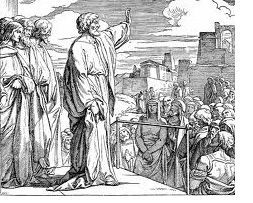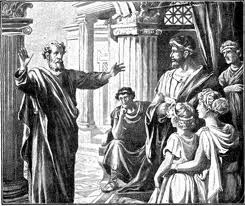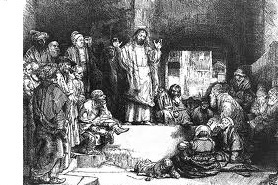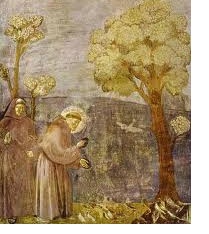After summarizing and transcribing each of the 100 homilies of my sample, I wrote a short analysis in three points: the messenger, the message, and the mystagogy. Combining the U.S. and the Guatemalan homilies (there is little difference between the two), I found the following distribution of my evaluations:
Positive evaluation of mystagogy 37%
Positive evaluation of message 25%
These percentages have more a symbolic value than a precisely quantitative one. They suggest the general feeling that homilists are friendly and dedicated to their work (67%), are moderately successful in conveying a truly spiritual dimension (37%), but less successful in articulating a simple and clear message (25%). Let us consider each of these dimensions.
1. The messenger.
If one loves the messenger, one is more like to love the message. Most homilists have attractive personalities. They appear as warm, pleasant, enthusiastic, speaking with conviction, youthful, friendly, likable, lovable, approachable, peaceful, smiling – these are some of the adjectives I used in my field notes to describe them. They often show good professional qualities like having prepared their homilies in writing, speaking in clear and powerful voice, and relating well to the audience. Those who were not described in positive terms were not unfriendly, but rather uncommunicative, reading their written text, inaudible, aloof, abstract and general, emotionless, of another age, perfunctory, or routine.
Priests are also community leader. This dimension comes through in notes like, “Speaks with great confidence. His style is casual, conversational, relational, confidence building, community building, Catholic culture centered.” Here are other discriptions: “Fatherly community leader; populist speaker; entertaining; good at community building; speaks a little like a politician: big words with little content.” Many priests show great self-confidence, even to the point of over-confidence. The last priestly persona is that of a holy or at least a pious man. In their homilies priests often appear humble and devout in tone and presentation, hortatory and invitational, meditative, even prayerful at times.
2. The message
Let us look at some of the 20% of homilies that present a simple and clear message, that is, the top 20%. “By a show of hands, how many have seen the royal wedding of Prince William and Kate?” Without much of a pause, the priest proclaimed, “Every wedding is a royal wedding. We are all sons of the same king. We are all the king’s kids. Amen? Amen! For Catholics, the Mass is a royal wedding when Christ gives himself to his bride the church. He wants to be number one is our lives.” As this was the Sunday of divine Mercy, the priest turned to the picture of Jesus described by Sr. Faustina. “This is the picture of the resurrected Jesus. Amen? His mercy is greater than all the sins of the world. ‘Jesus, help me!’ I want him to empower me, to forgive me, to strengthen me, so that we can serve others. ‘Jesus, I trust in you! You are merciful!’ Amen?” This homily would rank high, as did his celebration of the liturgy of the day.
Here are a few homilies I have already mentioned above. By telling the story of his three encounters with John Paul II, on the day of his beatification, the homilist combined personal recollections, the readings of the day, and the exhortation of Jesus “Don’t be afraid” (rather than the more stoic “Be brave”). Another homily integrated Word and Mystery with the repeated quotation, “Do not let your heart be troubled;” this short homily (six minutes) was memorable in its simplicity. “Love your enemies. I am coming soon” was a strong message of another homily, well suited for the day of Christ the King and in preparation for Advent. The evocation of the Last Judgment brought forth a response of religious silence in the assembly. In another homily the evocation of the message of Mother Teresa brought forth reverential silence. “For mother Teresa, we all long to be where God is, and it is in our power to be happy with him right now. Being with him 24 hours, that is, with the homeless, the refugees, the victims of floods and earthquakes, people in poverty. Every time we do these things at any scale, we eliminate a little hell and we create a little heaven in this world.” Here is the homily of a priest-community leader. “A visitor last Sunday left her wallet in church: do so again!” That laughter created immediate rapport. This community leader wanted to engage his parish, “In most parishes 10% make all things work. No! It should be all of us. Don’t delay! Some day is today! Get reconciled today! Take your phone or email. Half the people haven’t even made their will yet! Don’t delay! Our food pantry is low...” This call to action was quite effective.
3. Mystagogy
The above examples are very mystagogical in their content, but homilist can also convey mystagogy by the tone of their voice and the
In summary, out of all the100 homilies, I rated positively 19 on all three dimensions, which means that in 81% of them either the messenger, the message, or the mystagogical quality did not rank very high. This finding corroborates my conclusion about Sunday liturgies, as I found that the vast majority of the Masses were cultic, either priests’ Masses or the ministers’ performances. Often the priest’s recitation of the Eucharistic Prayer was perfunctory, and the homilies consisted of general comments about the readings, without originality and research. In short, the number of truly appealing homilies is only about one in five or so; the same can be said about Sunday liturgies.
That the content of Catholic homilies is relatively poor is well known. In the survey of the Notre Dame Parish study of 1983 only 15% of the parishioners found the homilies to be informative, versus 57% as uninformative (27% neutral); only 17% found them helpful to their faith but 52% unhelpful (31% neutral). Long before the U.S. Congregational Life Survey of 2001-2008, Greeley had reported lower approval rates among Catholics: only 18% of Catholics versus 26% of Protestant rated their homilies as excellent in 2000 (America Magazine, May 7, 2001).
The above analysis is a subjective evaluation. I turn next to a more objective analysis
DISCUSSION:
1) Analyze last Sunday’s homily in a neighboring parish in terms of messenger, message, and mystagogy. This is subjective, but this is also what people take home.
 Positive evaluation of homilist 67%
Positive evaluation of homilist 67% Implicit in the above positive description are three personas which priests tend to betray in their homilies: Mr. Nice, community leader, and man of God. Most if not all priests are friendly, as seen when they shake hands at the end of the Masses. They like to be Mr. Nice.
Implicit in the above positive description are three personas which priests tend to betray in their homilies: Mr. Nice, community leader, and man of God. Most if not all priests are friendly, as seen when they shake hands at the end of the Masses. They like to be Mr. Nice. Another powerful homily was that of a newly ordained priest in his seventies. “I am so grateful for being able to stand here before you as a priest of our Lord Jesus Christ the High Priest. I am especially honored and humbled that my First Mass takes place today on the solemnity of the Body and Blood of Christ. It is as priest at the altar that a priest is most a priest. He brings God to the people, and the people to God. I would like to express my joy of thanksgiving.” His thanksgiving was both mystagogical and emotional. “I also want to give thanks that this First Mass is taking place today, on June 26, the day of my father’s birthday [long applause]. He passed away about 7 years ago, but he is here with us now, and I know he is rejoicing and giving thanks with the rest of us. So, happy birthday, dad!”
Another powerful homily was that of a newly ordained priest in his seventies. “I am so grateful for being able to stand here before you as a priest of our Lord Jesus Christ the High Priest. I am especially honored and humbled that my First Mass takes place today on the solemnity of the Body and Blood of Christ. It is as priest at the altar that a priest is most a priest. He brings God to the people, and the people to God. I would like to express my joy of thanksgiving.” His thanksgiving was both mystagogical and emotional. “I also want to give thanks that this First Mass is taking place today, on June 26, the day of my father’s birthday [long applause]. He passed away about 7 years ago, but he is here with us now, and I know he is rejoicing and giving thanks with the rest of us. So, happy birthday, dad!” emotionality of their talk. It is well known that an illiterate peasant full of love of God can be more mystagogical than an erudite scholar full of words but little agape. Mystagogy is invitation and guidance into mystery; it is hard to describe its various manifestations. For anoutsider, there are clear signs: an unusual quality of silence, the absence of couching and tossing, serenity on people’s faces, the gaze looking inwards rather than lost in space, concentration on the present moment, sometimes deep and peaceful emotions. At the end of mystagogical service or homily, people are pensive, they are in no rush to leave, they are like in a sacred space and don’t want to return to the profane world, and their first words when coming out are about something spiritual. Durkheim, an atheist, described the sacred as “la vie sérieuse” (serious, earnest life).
emotionality of their talk. It is well known that an illiterate peasant full of love of God can be more mystagogical than an erudite scholar full of words but little agape. Mystagogy is invitation and guidance into mystery; it is hard to describe its various manifestations. For anoutsider, there are clear signs: an unusual quality of silence, the absence of couching and tossing, serenity on people’s faces, the gaze looking inwards rather than lost in space, concentration on the present moment, sometimes deep and peaceful emotions. At the end of mystagogical service or homily, people are pensive, they are in no rush to leave, they are like in a sacred space and don’t want to return to the profane world, and their first words when coming out are about something spiritual. Durkheim, an atheist, described the sacred as “la vie sérieuse” (serious, earnest life).
2) Discuss what YOU would consider a good messenger, message, and mystagogy. What qualities are found or missing in the homilies you are familiar with?